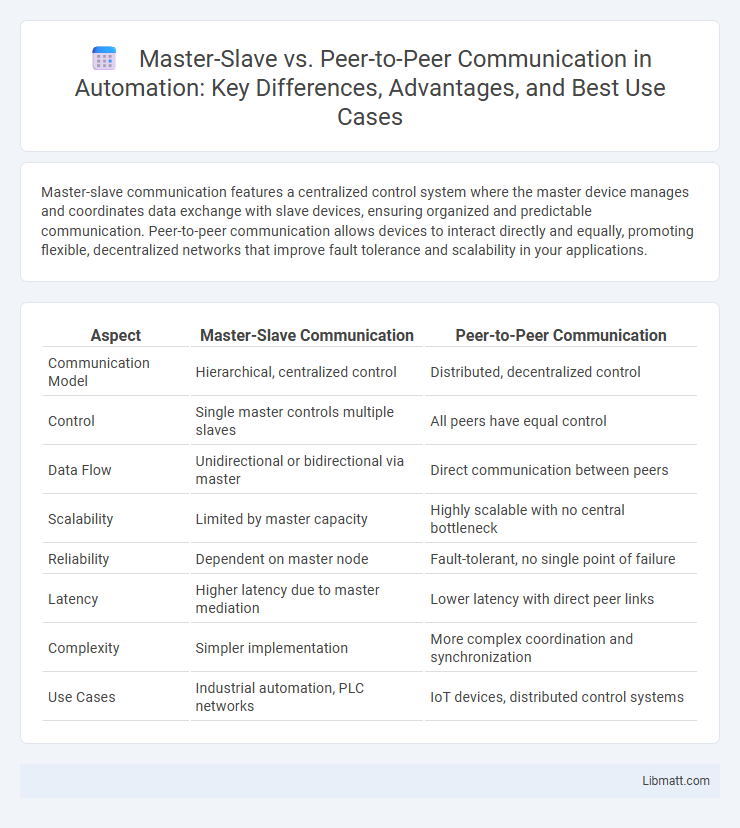Master-slave communication features a centralized control system where the master device manages and coordinates data exchange with slave devices, ensuring organized and predictable communication. Peer-to-peer communication allows devices to interact directly and equally, promoting flexible, decentralized networks that improve fault tolerance and scalability in your applications.
Table of Comparison
| Aspect | Master-Slave Communication | Peer-to-Peer Communication |
|---|---|---|
| Communication Model | Hierarchical, centralized control | Distributed, decentralized control |
| Control | Single master controls multiple slaves | All peers have equal control |
| Data Flow | Unidirectional or bidirectional via master | Direct communication between peers |
| Scalability | Limited by master capacity | Highly scalable with no central bottleneck |
| Reliability | Dependent on master node | Fault-tolerant, no single point of failure |
| Latency | Higher latency due to master mediation | Lower latency with direct peer links |
| Complexity | Simpler implementation | More complex coordination and synchronization |
| Use Cases | Industrial automation, PLC networks | IoT devices, distributed control systems |
Introduction to Communication Architectures
Master-Slave communication architecture features a hierarchical model where a single master device controls multiple slave devices, coordinating data exchange and task execution. Peer-to-Peer communication allows all connected devices to interact directly with each other, enabling decentralized data sharing and equal role distribution. These architectures influence network design choices based on factors such as scalability, fault tolerance, and communication latency.
Defining Master-Slave Communication
Master-Slave communication is a hierarchical network model where a single master device controls one or more slave devices, orchestrating data exchange and task management. The master initiates commands, while slaves respond without initiating communication independently, ensuring synchronized and controlled operations. This structure enhances reliability and predictability in systems requiring centralized control, such as industrial automation and embedded systems.
Key Features of Master-Slave Systems
Master-slave communication systems feature a centralized control model where the master device coordinates and manages communication with multiple slave devices, ensuring organized data exchange and command execution. Slaves respond only to the master's requests, which enhances predictability and reduces data collisions in network traffic. This structure is ideal for industrial automation and real-time control systems where precise command sequencing and timing are critical.
Understanding Peer-to-Peer Communication
Peer-to-peer communication enables devices to connect and exchange data directly without relying on a central controller, enhancing network scalability and resilience. Each node in a peer-to-peer network acts as both a client and server, sharing resources equally and facilitating decentralized control. This communication model supports distributed applications, improves fault tolerance, and reduces latency compared to master-slave architectures.
Core Characteristics of Peer-to-Peer Networks
Peer-to-peer (P2P) networks feature decentralized communication where each node acts as both client and server, enabling direct data exchange without a central authority. These networks provide enhanced scalability and fault tolerance since nodes can dynamically join or leave without disrupting the overall system. Distributed resource sharing, redundancy, and equal node collaboration are fundamental characteristics that differentiate P2P from hierarchical master-slave architectures.
Comparative Analysis: Master-Slave vs Peer-to-Peer
Master-Slave communication centralizes control in a primary device that manages multiple secondary devices, providing predictable synchronization and reduced complexity in network management. Peer-to-Peer communication distributes control equally among nodes, enhancing fault tolerance and scalability while enabling direct data exchange without reliance on a single controller. The choice between architectures depends on system requirements for control hierarchy, latency, and robustness in applications such as industrial automation or decentralized networks.
Advantages of Master-Slave Communication
Master-slave communication offers centralized control, ensuring efficient coordination and streamlined decision-making processes in your network. It provides reliable synchronization and predictable data flow, which reduces conflicts and enhances system stability. This structure simplifies troubleshooting and maintenance by clearly defining roles and hierarchy among connected devices.
Benefits of Peer-to-Peer Communication
Peer-to-peer communication enhances network resilience by eliminating single points of failure and enabling direct data exchange between devices, which improves speed and reduces latency. This decentralized model supports scalable and flexible connections, allowing Your systems to dynamically adapt to changing network conditions without relying on a central coordinator. Increased fault tolerance and resource sharing efficiency make peer-to-peer communication ideal for modern distributed applications and real-time collaboration.
Use Cases and Real-world Applications
Master-Slave communication is commonly used in industrial automation systems such as PLC networks, where a central controller (master) commands multiple slave devices for synchronized control and data collection. Peer-to-Peer communication is prevalent in decentralized systems like blockchain networks and mesh Wi-Fi, enabling direct interactions between nodes for enhanced scalability and fault tolerance. Real-world applications for Master-Slave architectures include Modbus and CAN bus in automotive and manufacturing, while Peer-to-Peer models power file-sharing platforms and IoT device communication.
Choosing the Right Architecture for Your Needs
Master-slave communication architecture centralizes control in a single master device that manages multiple slave devices, ideal for applications requiring synchronized data flow and predictable timing. Peer-to-peer communication enables equal-status devices to exchange information directly, enhancing scalability and fault tolerance for dynamic, decentralized networks. Selecting the right architecture depends on factors like network size, communication latency requirements, and system complexity.
Master-Slave vs Peer-to-Peer Communication Infographic

 libmatt.com
libmatt.com